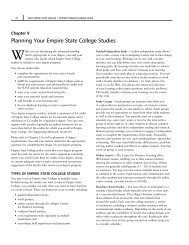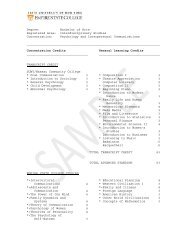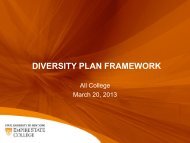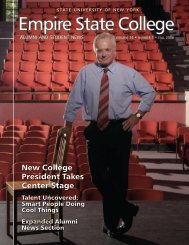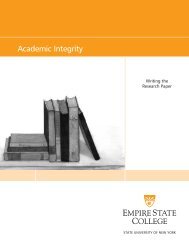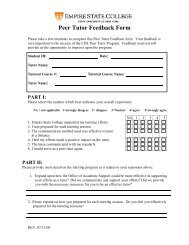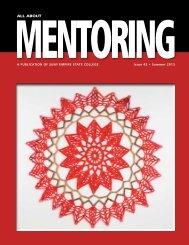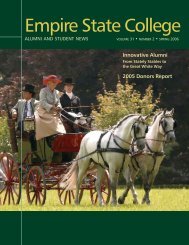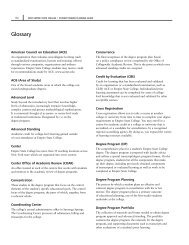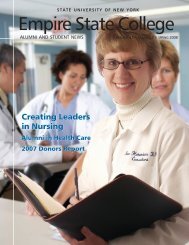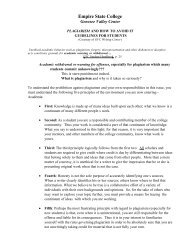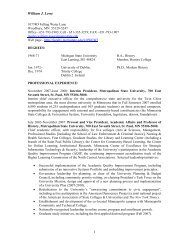Academic Plan 2011-2015 (PDF 524kB) - SUNY Empire State College
Academic Plan 2011-2015 (PDF 524kB) - SUNY Empire State College
Academic Plan 2011-2015 (PDF 524kB) - SUNY Empire State College
You also want an ePaper? Increase the reach of your titles
YUMPU automatically turns print PDFs into web optimized ePapers that Google loves.
<strong>SUNY</strong> <strong>Empire</strong> <strong>State</strong> <strong>College</strong>: <strong>Academic</strong> <strong>Plan</strong> <strong>2011</strong> - <strong>2015</strong> 15is growing. Accordingly, not all curricular areas identified for support hold the identical promise forjob growth or material prosperity for our graduates. Yet, all represent fields with an expanding rangeof opportunity.It is recommended that we remain vigilant in seeking to support curricular proposals which allowthe college and our students to make substantive contributions to their fields, especially in fieldswhich have an increasing role in, or influence on society. The eight curricular areas for support wereidentified, in part, because of their prominence and stature in society, as well as their ability to benefitthe economic interests of the college.Criterion 4: Integrates effectively with other curricular areas and is conducive to interdisciplinaryapproaches to program and curriculum developmentThe desire for a more interdisciplinary approach to planning and delivering educational services hasbeen expressed in multiple forums with consistency and enthusiasm. Benefits accrue to students andfaculty. Our commitments to students – particularly because of our adult-learner student body – areserved more generously to the extent we provide unrestricted access to relevant learning opportunitieswherever they occur in the college. In a similar fashion, our commitments to faculty – especially withrespect to professional development – are strengthened to the extent we can engage one another morefully in collaborative endeavors.Therefore, it is proposed that curricular areas which complement or integrate with other areas willreceive more favorable attention. The eight themes proposed for academic emphasis share thepotential for mutually influencing one another. The educational cachet of each academic area isenriched to the degree it is informed by the other areas. Consider these examples:• The range of possibilities for managing in a health care environment is broadened whenstudents become aware of health care policies and practices in globally diverse settings, as wellas understand how emerging information system technologies affect patients’ ease of obtainingcare across a spectrum of health care organizations.• Sustainability constitutes both an area of study as well as a theme with relevance to all othercurricular areas.• The impact on labor of shifts in the world economy, emerging technologies and modificationsof consumer needs is quite considerable. The distribution of labor on a global basis and itsrelationship to business as the 21st century progresses relate well to the interconnectedness ofthe proposed areas of curricular emphasis.Criterion 5: Reflects and builds on the expertise of our faculty<strong>Empire</strong> <strong>State</strong> <strong>College</strong> has a rich and diverse scholarly community, comprising faculty who often haveprior experiences as practitioners in their respective fields and now are engaged actively in teachingand scholarship. In choosing which academic areas to focus on, it is, therefore, desirable to draw uponthe expertise of the current faculty who are accomplished already in their fields, and who are poised tomake further contributions in their given areas. At the same time, it is useful to view this criterion as avehicle by which to identify where investments should be made to further develop the faculty, as wellas to guide future hiring decisions, based on the need to augment certain areas. One of the guidingprinciples in adopting this criterion is that it implicitly endorses the idea that <strong>Empire</strong> <strong>State</strong> <strong>College</strong> isone college. The expertise of the faculty is, thus, a shared resource, and can be drawn upon by various




